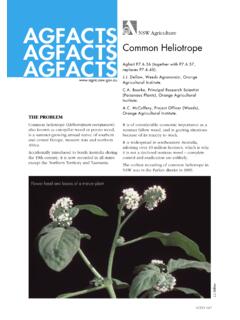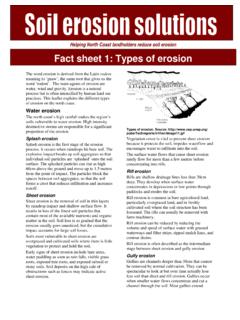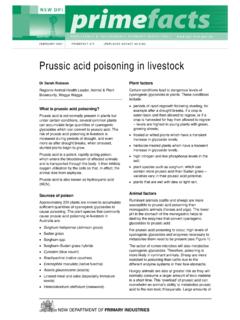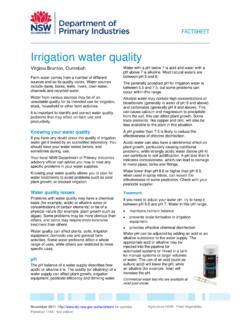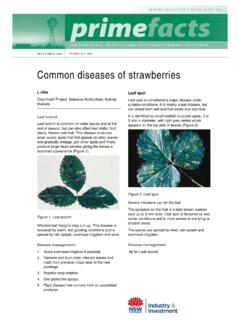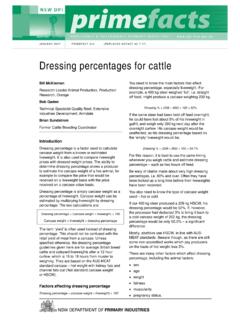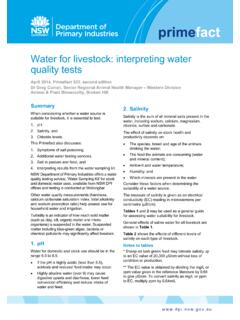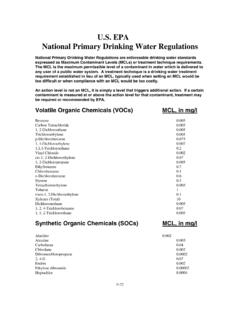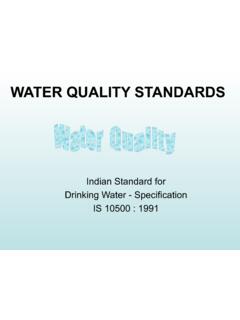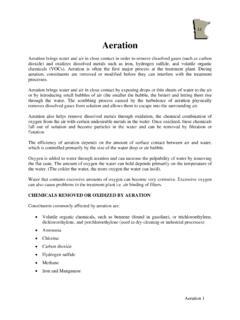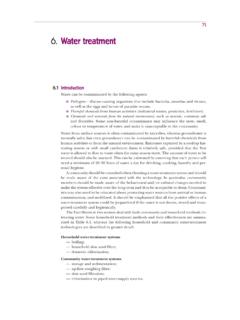Transcription of Farm water quality and treatment
1 farm water quality and treatmentMarch 2014 Primefact 1337, first edition Agriculture NSW water Unit farm water comes from a number of different sources and so its quality varies. water sources include dams, bores, wells, rivers, town water , channels and recycled water . water from various sources may be of an unsuitable quality for its intended use for irrigation, stock, household or other farm activities. It is important to identify and correct water quality problems that may effect on- farm use and productivity. Knowing your water quality If you have any doubt about the quality of water you intend to use for irrigation, stock or domestic purposes, get it tested by an accredited laboratory. You should have your water tested before, and sometimes during, use. Your Local Land Services advisory officer may provide assistance to find information and identify options to manage specific problems in your water supplies. Knowing your water quality allows you to plan for water treatments to avoid problems such as poor plant growth, blocked irrigation or stock watering pipes, staining and other undesirable effects of poor water quality .
2 water quality issues Problems with water quality may be chemical (for example, acidic or alkaline water or concentrations of certain elements) or physical (for example, plant growth such as algae). Some problems may be more obvious than others, and some may require more extensive treatment . water quality can affect plants, soils, livestock, irrigation equipment, domestic use and general farm activities. water quality problems may affect a range of uses, or be restricted to more specific uses. This Primefact discusses the following common water quality issues, and methods of treating them: pH iron hardness corrosion salinity sodicity turbidity algae colour, taste and odour bacterial growth. It also discusses the following processes aimed at improving overall water quality : disinfecting irrigation water filtration systems farm water quality and treatment monitoring water quality , A list of references and further reading is also provided. pH The pH balance of a water supply describes how acidic or alkaline it is.
3 The acidity (or alkalinity) of a water supply can affect plant growth, irrigation equipment, pesticide efficiency and drinking water suitability. The balance of positive hydrogen ions (H+) and negative hydroxide ions (OH ) in water determines its pH level. The pH scale goes from 0 to 14, and a pH of 7 is neutral. water with a pH below 7 is increasingly acidic and pH above 7 is increasingly alkaline. Most natural waters are between pH 5 and 8. The generally acceptable range of pH for irrigation water is between and , but some problems can still occur within this range. For example, alkaline water may contain high concentrations of bicarbonate (generally in water of pH 8 and above) and carbonates (generally pH 9 and above). High bicarbonate and carbonate levels in water can cause calcium to precipitate from the soil. This reduces the soil s exchangeable calcium content and increases soil sodicity. Magnesium can also be lost in this way. In extreme cases, the loss of soil calcium and magnesium will affect plant growth.
4 Some trace elements, like copper and zinc, will also be less available to the plant in this situation. The precipitation of calcium carbonate from water can also cause equipment blockages. Precipitation: In chemical terms, when a substance separates out of a solution in solid form. A pH greater than is likely to reduce the effectiveness of chlorine disinfection. Acidic water can have a detrimental effect on plant growth, particularly causing nutritional problems, while strongly acidic water (below pH 4) can contribute to soil acidification. A pH less than 6 indicates corrosiveness, which can lead to damage to metal pipes, tanks and fittings. water with pH less than or greater than pH , when used in spray mixes, can lessen the effectiveness of some pesticides. Check with your pesticide supplier. An acceptable pH for domestic purposes is between and This range is set primarily for aesthetic, corrosion and encrustation reasons rather than health-related reasons. For example, drinking water with a pH of 5 will not cause health problems in fact, some soft drinks may be 10 to 100 times more acidic than this.
5 However, if you have any concerns with your drinking water quality you should contact the NSW Department of Health. treatment If you need to adjust your water pH, try to keep it between pH and pH 7. water in this pH range: maintains nutrient balance prevents scale formation in irrigation equipment provides effective chemical disinfection. water pH can be adjusted by adding an acid or an alkaline substance to the water supply. The appropriate substance may be injected into the pipeline for automated systems or mixed in a tank for manual systems or larger volumes of water . The use of an acid (such as sulfuric acid) will lower the pH, while an alkaline substance (for example, lime) will increase the pH. The selection of pH treatment will depend on the intended use of the water and the particular situation. The local office of Local Land Services may be able to provide some assistance in developing treatment options. iron Soluble iron and iron -loving bacteria can cause blockages in pipes, drippers and sprinklers and can damage equipment such as pressure gauges.
6 If water with high soluble iron is applied by spray, it can discolour leaves and reduce the efficiency of transpiration and photosynthesis. 2 NSW Department of Primary Industries, August 2014 farm water quality and treatment High levels of soluble iron are usually associated with deep bores and dams where oxygen supply is limited. iron is soluble in water where there is little or no oxygen. Aeration oxidises the iron , forming solid particles that can then settle out of solution. Dissolved iron can promote the growth of iron bacteria in groundwater. The presence of bacteria worsens the impacts of soluble iron , as they extract the iron out of solution and convert it into sludge. Oxidised iron , even in low concentrations of mg/l, stimulates some aerobic slime deposits. These slimes are sticky and can attach themselves to irrigation pipes causing blockages. Heavy iron deposits can make pasture unpalatable to stock. If eaten, the iron deposits may cause dairy cattle to scour and milk production to drop.
7 iron deposits on vegetables, fruit and ornamental plants make them difficult to sell because of their stained appearance. As a general guide, iron bacteria will develop in water where the concentration range of iron is to mg/L ( to parts per million, ppm). Concentrations above mg/L ( ppm) tend to favour the development of iron deposits. Irrigation systems used for fertigation (liquid feeding of nutrients) should not use water high in iron . Injecting unchelated phosphates or calcium salts into the water will accelerate the precipitation of iron , and should be avoided. In domestic water supplies, iron and manganese will turn the water yellow-brown to black and will stain plumbing fixtures and laundry. iron can also dramatically reduce the efficiency of water -softening units. treatment iron is soluble in water where there is little or no oxygen. Oxidising the iron makes it form solid particles that can then settle out of solution or be caught in a filter. The recommended treatment to remove iron is oxidation, sedimentation and then filtration .
8 Procedures used include aeration and settling (Figure 1), chlorination and use of potassium permanganate. Figure 1. Aeration and settling to remove iron Aeration and settling Aeration and settling is an inexpensive and almost foolproof method of iron removal. Aeration means the water is mixed with air, by: spraying the water into the air bleeding air into the intake side of a pump agitating the water with propellers or paddles cascading it over baffles into a settling tank. The iron then settles out of the aerated water . Because iron is more soluble at lower pH values, the best precipitation is likely to occur at a pH of You can add hydrated lime, that is, calcium hydroxide Ca(OH)2, to raise the pH values. Rates of 30 grams per 1000 litres of water are often used but other features of water quality and types of treatment , storage and delivery must all be considered. Too much hydrated lime can create hard water for example (see Hardness ). In dams, problems caused by iron can often be reduced or eliminated by attaching the suction pipe of the pump to a raft or drum to bring it within 20 to 30 cm of the surface (Figure 2).
9 3 NSW Department of Primary Industries, August 2014 farm water quality and treatment The most commonly used aerators are cascade aerators. The simplest cascade aerator is a series of steps that spread the water and allow it to fall from one level to another. A one-metre head (4 to 5 steps of 20 cm height) is usually sufficient, but more steps will give a more complete aeration. Increasing the number of steps extends the exposure time and adds obstructions to increase turbulence. (Figure 3) Aeration can also be achieved using an aerating pump (see Figure 8 in the section on Algae ). For household use, cascade water into a tank, allow it to settle for a few hours and then draw off through a pipe set 30 cm below the surface. A plug in the bottom of the tank allows sediment to be flushed out periodically. With two tanks, one can be used while the other is filled and allowed to settle (see Figure 3). In many instances, chlorine may be added following aeration to aid oxidation. Figure 2.
10 Using a floating suction will reduce iron problems Figure 3. A simple cascade used to aerate water for iron removal 4 NSW Department of Primary Industries, August 2014 farm water quality and treatment Chlorination As a further control, following aeration and settling, chlorination can be used to control iron deposits if pH is below and the iron concentration is less than mg/L ( ppm). If pH is above , the iron concentration must be below mg/L ( ppm) to use chlorination effectively. Chlorine also kills iron bacteria on contact. Potassium permanganate Potassium permanganate (Condy s crystals) oxidises iron into insoluble oxide. Potassium permanganate is often used with manganese greensand, which acts as a filter, trapping the oxide. The main advantage of potassium permanganate oxidation is the high rate of reaction, which is many times faster than that of chlorine. The reaction is not sensitive to pH within the range of 5 to 9. Other products such as zeolite (manufactured greensand is manganese dioxide-coated zeolite) can be used instead of greensand and potassium permanganate to improve the oxidation process.

